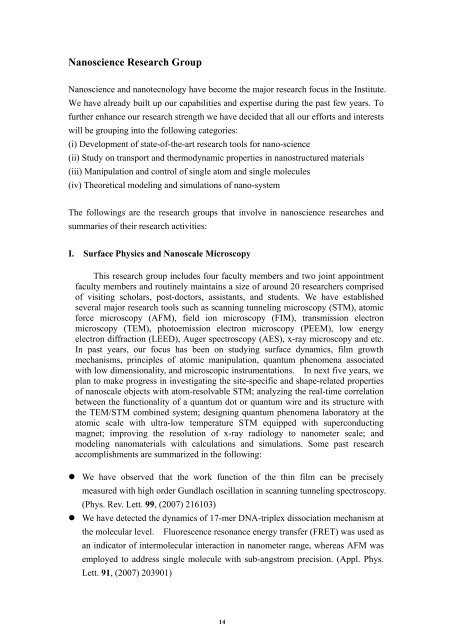2007 Annual Report Vol.35 - 中研院物理研究所- Academia Sinica
2007 Annual Report Vol.35 - 中研院物理研究所- Academia Sinica
2007 Annual Report Vol.35 - 中研院物理研究所- Academia Sinica
You also want an ePaper? Increase the reach of your titles
YUMPU automatically turns print PDFs into web optimized ePapers that Google loves.
Nanoscience Research Group<br />
Nanoscience and nanotecnology have become the major research focus in the Institute.<br />
We have already built up our capabilities and expertise during the past few years. To<br />
further enhance our research strength we have decided that all our efforts and interests<br />
will be grouping into the following categories:<br />
(i) Development of state-of-the-art research tools for nano-science<br />
(ii) Study on transport and thermodynamic properties in nanostructured materials<br />
(iii) Manipulation and control of single atom and single molecules<br />
(iv) Theoretical modeling and simulations of nano-system<br />
The followings are the research groups that involve in nanoscience researches and<br />
summaries of their research activities:<br />
I. Surface Physics and Nanoscale Microscopy<br />
This research group includes four faculty members and two joint appointment<br />
faculty members and routinely maintains a size of around 20 researchers comprised<br />
of visiting scholars, post-doctors, assistants, and students. We have established<br />
several major research tools such as scanning tunneling microscopy (STM), atomic<br />
force microscopy (AFM), field ion microscopy (FIM), transmission electron<br />
microscopy (TEM), photoemission electron microscopy (PEEM), low energy<br />
electron diffraction (LEED), Auger spectroscopy (AES), x-ray microscopy and etc.<br />
In past years, our focus has been on studying surface dynamics, film growth<br />
mechanisms, principles of atomic manipulation, quantum phenomena associated<br />
with low dimensionality, and microscopic instrumentations. In next five years, we<br />
plan to make progress in investigating the site-specific and shape-related properties<br />
of nanoscale objects with atom-resolvable STM; analyzing the real-time correlation<br />
between the functionality of a quantum dot or quantum wire and its structure with<br />
the TEM/STM combined system; designing quantum phenomena laboratory at the<br />
atomic scale with ultra-low temperature STM equipped with superconducting<br />
magnet; improving the resolution of x-ray radiology to nanometer scale; and<br />
modeling nanomaterials with calculations and simulations. Some past research<br />
accomplishments are summarized in the following:<br />
• We have observed that the work function of the thin film can be precisely<br />
measured with high order Gundlach oscillation in scanning tunneling spectroscopy.<br />
(Phys. Rev. Lett. 99, (<strong>2007</strong>) 216103)<br />
• We have detected the dynamics of 17-mer DNA-triplex dissociation mechanism at<br />
the molecular level. Fluorescence resonance energy transfer (FRET) was used as<br />
an indicator of intermolecular interaction in nanometer range, whereas AFM was<br />
employed to address single molecule with sub-angstrom precision. (Appl. Phys.<br />
Lett. 91, (<strong>2007</strong>) 203901)<br />
14
















